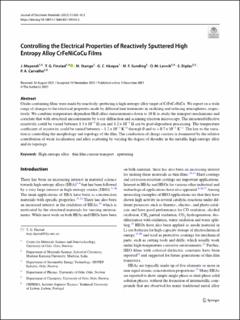| dc.contributor.author | Mayandi, Jeyanthinath | |
| dc.contributor.author | Finstad, Terje Gunnar | |
| dc.contributor.author | Stange, Marit Synnøve Sæverud | |
| dc.contributor.author | Vasquez, Geraldo Cristian | |
| dc.contributor.author | Sunding, Martin Fleissner | |
| dc.contributor.author | Løvvik, Ole Martin | |
| dc.contributor.author | Diplas, Spyridon | |
| dc.contributor.author | Almeida Carvalho, Patricia | |
| dc.date.accessioned | 2022-04-01T13:45:30Z | |
| dc.date.available | 2022-04-01T13:45:30Z | |
| dc.date.created | 2021-12-09T11:52:43Z | |
| dc.date.issued | 2021 | |
| dc.identifier.citation | Journal of Electronic Materials. 2021, 51 803-812. | en_US |
| dc.identifier.issn | 0361-5235 | |
| dc.identifier.uri | https://hdl.handle.net/11250/2989349 | |
| dc.description.abstract | Oxide-containing films were made by reactively sputtering a high-entropy alloy target of CrFeCoNiCu. We report on a wide range of changes to the electrical properties made by different heat treatments in oxidizing and reducing atmospheres, respectively. We combine temperature-dependent Hall effect measurements down to 10 K to study the transport mechanisms and correlate that with structural measurements by x-ray diffraction and scanning electron microscopy. The measured/effective resistivity could be varied between 1.3 × 10−4 Ω cm and 1.2 × 10−3 Ω cm by post-deposition processing. The temperature coefficient of resistivity could be varied between − 1.2 × 10−3 K−1 through 0 and to + 0.7 × 10−3 K−1. The key to the variation is controlling the morphology and topology of the film. The conduction of charge carriers is dominated by the relative contribution of weak localization and alloy scattering by varying the degree of disorder in the metallic high-entropy alloy and its topology. | en_US |
| dc.language.iso | eng | en_US |
| dc.publisher | Springer Nature | en_US |
| dc.rights | Navngivelse 4.0 Internasjonal | * |
| dc.rights.uri | http://creativecommons.org/licenses/by/4.0/deed.no | * |
| dc.title | Controlling the Electrical Properties of Reactively Sputtered High Entropy Alloy CrFeNiCoCu Films | en_US |
| dc.type | Peer reviewed | en_US |
| dc.type | Journal article | en_US |
| dc.description.version | publishedVersion | en_US |
| dc.rights.holder | This article is licensed under a Creative Commons Attribution 4.0 International License, which permits use, sharing, adaptation, distribution and reproduction in any medium or format, as long as you give appropriate credit to the original author(s) and the source, provide a link to the Creative Commons licence, and indicate if changes were made. The images or other third party material in this article are included in the article’s Creative Commons licence, unless indicated otherwise in a credit line to the material. If material is not included in the article’s Creative Commons licence and your intended use is not permitted by statutory regulation or exceeds the permitted use, you will need to obtain permission directly from the copyright holder. To view a copy of this licence, visit http://creativecommons.org/licenses/by/4.0/. | en_US |
| dc.source.pagenumber | 803-812 | en_US |
| dc.source.volume | 51 | en_US |
| dc.source.journal | Journal of Electronic Materials | en_US |
| dc.identifier.doi | 10.1007/s11664-021-09343-3 | |
| dc.identifier.cristin | 1966611 | |
| dc.relation.project | Norges forskningsråd: 275752 | en_US |
| dc.relation.project | Norges forskningsråd: 245963 | en_US |
| cristin.ispublished | true | |
| cristin.fulltext | original | |
| cristin.qualitycode | 1 | |

